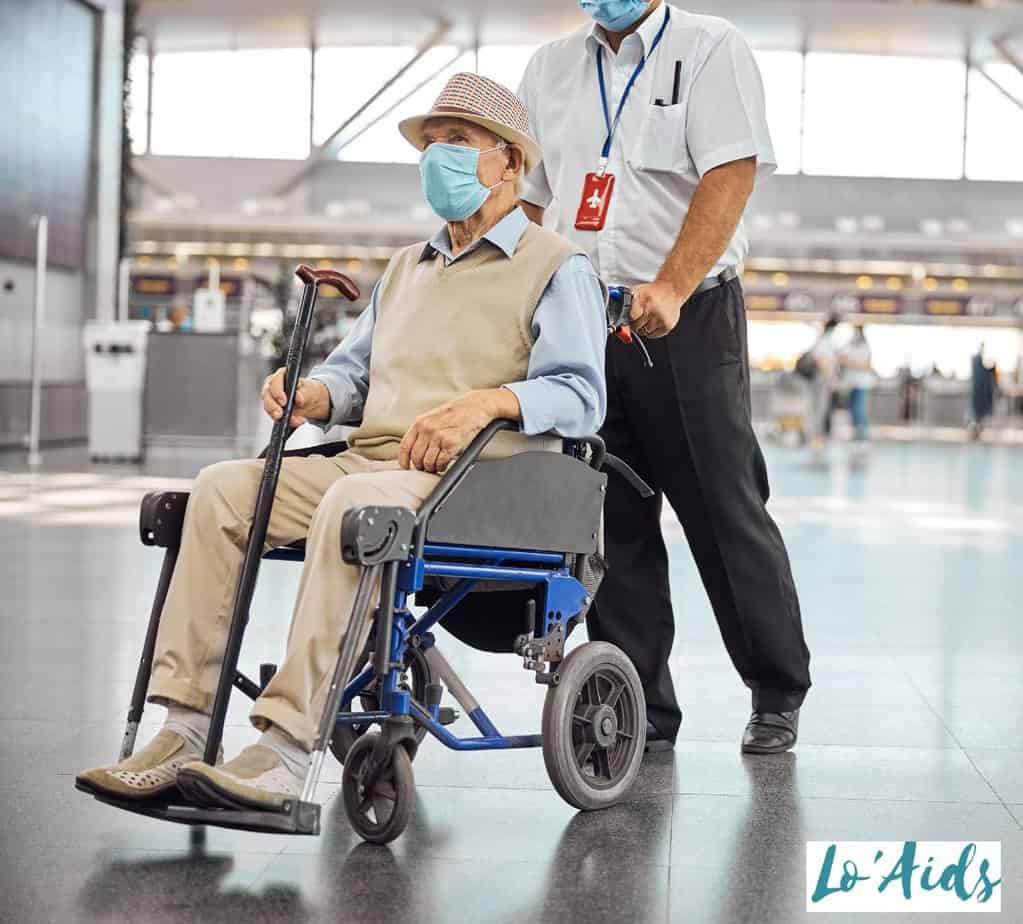Did you know that approximately 2 million people in the United States rely on a wheelchair or an assistive mobility device for movement? [1]
Half of these users may suffer wheelchair injuries while using a wheelchair, which can vary from minor scrapes and bruises to fractured bones, head trauma, and even brain traumatic brain injuries!
Falling out of a wheelchair is just something that comes with the territory! Well, that’s why I’m writing this article: to share some tips on how to prevent your patient from sliding out of a chair.
So take a deep breath, and get ready to learn some ways to prevent falls!
Make sure to also check our list of top wheelchair brands!
Table of Contents
4 Reasons Why Chair Users Fall Out
If you’re a caregiver or a worker in nursing home care, you know that one of the most challenging things to deal with is when a nursing home resident who uses a wheelchair falls out of their chair.
Here are some reasons why they fall:
1. Improper Fit
This is one of the most common reasons for falls. An improper wheelchair fit can cause the user to lose balance and fall out, causing minor to severe injuries.
An improper wheelchair fit means that your patient’s leg rest, leg brace, or footplate isn’t at the right height, which can throw their balance off. [2]
2. Poorly Maintained Wheels
If the wheelchair’s wheels are poorly maintained, a fall will be inevitable. Poorly maintained wheels can cause the chair to become unstable and more likely to topple and fall over.
3. Vision Problems
According to a study, seniors in chairs with vision problems are one of the major reasons for falls. [3]
This is because they may not be able to see obstacles in their path, which can cause them to trip or lose their balance.

4. Physical Weakness or Instability
If a manual chair user is weak or unstable, they can easily fall. This is because they may not have the strength to hold themselves upright or stay in their chair for an extended period.
ALSO CHECK: How to Recycle Wheelchair
How to Stop Someone From Falling Out: Fall Prevention
When it comes to fall prevention, you can do a few things for your patients to prevent sliding out of chairs and make sure that they are safe and bones-free.
Below, I’ll go over some tips to stop someone from falling out of a wheelchair:
READ MORE: User’s Guide to Price of Wheel Chair
1. Encourage Your Patient to Get Physical Therapy
One of the best ways to prevent falls is to get physical therapy and encourage your patient to participate in a therapy program.
Physical therapists can help improve the strength and stability of patients, which can make it less likely for them to fall out of their chairs. [4]

They can also help with balance and coordination, which are essential for chair users. Ask the physical therapist about fall prevention exercises that your patient can do at home.
2. Encourage the Patient to Be Active
If your patient is inactive, they are more likely to fall. Inactivity can cause the patient to become weak and more likely to lose their balance, especially in elderly people.
Therefore, it’s essential to encourage the patient to be as active as possible. This can include walking, moving around in their chair, or doing simple exercises.
If you work in nursing homes, encourage your fellow nursing staff to facilitate daily exercise. Put on some music, dance like a reality star, and avoid fatal accidents.
Check out the video below for inspiration!
3. Check the Patient’s Wheelchair
This is obvious. Another key way to prevent falls is to use the right chair.
Make sure to check your patient’s chair if it’s properly fitted for them, has the necessary physical restraint, and has well-maintained wheels.
Consider recommending one that has the following safety features:
- seat belts
- seat alarm or chair alarm
- lap belts
- adjustable seat depths
- adjustable seat angle
These features will prevent a whole lot of accidents!
Check out our article titled ‘Are Wheelchair Belts Considered a Type of Physical Restraint?’ for an in-depth discussion on the topic and to learn more about the legal implications and best practices surrounding the use of wheelchair belts.
Check the video below to make sure that your patient’s wheelchair is in good working condition or if it needs a little tweak:
4. Be Aware of the Patient’s Surroundings
It’s important to be aware of your patient’s surroundings to prevent sliding out of a wheelchair.
This means being aware of obstacles that could cause them to trip, such as cords or rugs.
You should also ensure that the area is well-lit so that the patient can see where they’re going. Lastly, try to keep the area free of clutter so that the patient can move around easily.
Also Read: The Best Way to Move a Chair Into an Elevator
5. Use Proper Transfer Techniques
Lastly, it’s essential to use the proper technique whenever you’re transferring a patient from their wheelchair. [5]
This means using your legs to lift them rather than your back and ensuring that the patient is secure before moving them.
Below is a video that shows the proper wheelchair transfer technique so that you can do it right.
How Do You Get Someone Up From a Fall in a Wheelchair?
Don’t wait for the fireman to arrive if you see someone falling out of a wheelchair. Do it yourself! Here are some tips on how to get someone up from a fall in a wheelchair:
1. Make sure that the person is okay. Check for any injuries or if they are bleeding. If so, call 911 immediately.
2. If the person is not injured, try to assess how they fell. This will help you determine the best way to get them back into their chair.
3. If the person can help you, have them grab onto your arms and pull themselves up.
4. If the person is unable to help you, you will need to lift them back into their chair. Place one arm under their legs and the other arm around their back. Lift them up carefully and place them back into their chair.
5. Once they are in their chair, strap them in so that they don’t fall out again.
Frequently Asked Questions
Are wheelchair belts considered restraints?
Wheelchair belts are not considered restraints. Instead, they are simply a safety measure to ensure that the person does not fall out of their chair.
What are some common injuries from falls?
Common injuries from falls include cuts, bruises, and broken bones. More severe injuries can include concussions and head injuries.
What is the best way to secure a wheelchair restraint?
There are several different ways to secure a wheelchair restraint. The most common is to use Velcro straps, but buckles or clips can also be used.
Whichever method you choose, make sure that the restraints are not too tight and that the person can still move their arms and legs comfortably.
Conclusion
Falling out of a wheelchair is a common occurrence for wheelchair users, but there are ways to prevent them.
Luckily for you, I did all the heavy work and compiled all the ways to prevent falls in one place. With the tips shared in this article, you can stop your patient from falling out of a wheelchair.
Thanks for reading!

Do you have your own prevention guidelines when it comes to wheelchair fall outs? Let us know in the comments down below!
References
- 1. Wheelchair Injuries [Internet]. www.lawyersthatfightforyou.com. Available from: https://www.lawyersthatfightforyou.com/nursing-home-assisted-living-issues/2020/05/13/wheelchair-injuries/
- 2. Sprigle S. Measure It. Advances in Skin & Wound Care. 2014;27:561–72.
- 3. Rubenstein LZ, Josephson KR, Robbins AS. Falls in the nursing home. Annals of internal medicine [Internet]. United States; 1994 [cited 2019 Jun 26];121:442–51. Available from: https://www.ncbi.nlm.nih.gov/pubmed/8053619
- 4. Hillegass E, Puthoff M, Frese EM, Thigpen M, Sobush DC, Auten B. Role of Physical Therapists in the Management of Individuals at Risk for or Diagnosed With Venous Thromboembolism: Evidence-Based Clinical Practice Guideline. Physical Therapy. 2015;96:143–66.
- 5. Tsai C-Y, Boninger ML, Bass SR, Koontz AM. Upper-limb biomechanical analysis of wheelchair transfer techniques in two toilet configurations. Clinical Biomechanics [Internet]. 2018;55:79–85. Available from: https://www.sciencedirect.com/science/article/abs/pii/S0268003318303188





